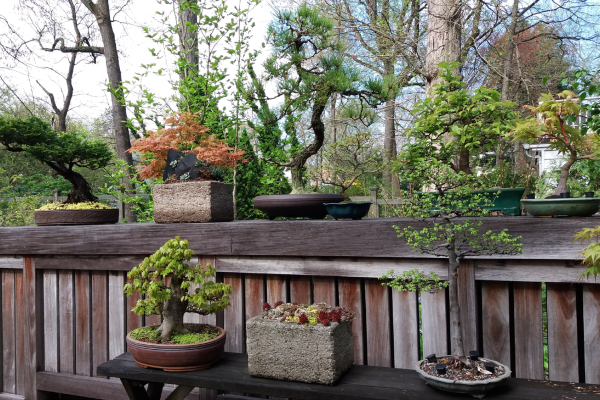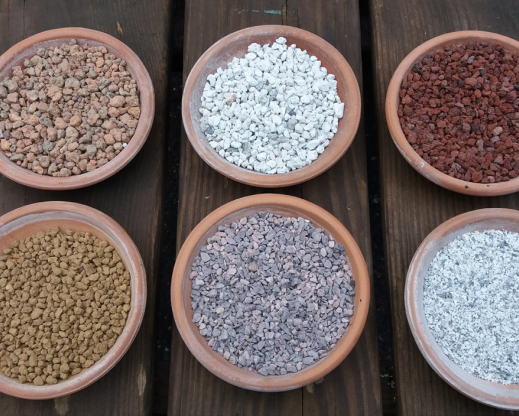Growing Medium
In both bonsai and rock gardening, horticultural success starts with an appropriate growing medium. Effective bonsai soil mixes for conifers drain well and include a limited amount of organic matter. Pumice, crushed granite, haydite, lava rock, and akadama (a naturally occurring, granular clay-like mineral imported from Japan) are commonly used for conifers in the bonsai community. All of them are good components of a soil mix for a rock garden or trough, also, since most rock garden soil mixes traditionally drain well and are on the lean side. In both cases, the gardener wants a mix that will provide a moist environment with excellent drainage, oxygen for the roots, and an environment that nutritionally encourages slow, steady growth. Organic fertilizer rather than inorganic fertilizer is recommended for bonsai to give a slow-but-steady release of essential nutrients. Both rock gardeners and bonsai artists want healthy conifers but not ones with rank growth. If you’ve had problems with raccoons and other critters being attracted to past use of organic fertilizers, consider products like OOF (Odorless Organic Fertilizer).
Sunlight
Most conifers trained as bonsai, and conifers growing in troughs and rock gardens, benefit from full to mostly full sun. Because they are grown in pots, conifer bonsai can be rotated so all sides of the plant get maximum exposure to sunlight. Bonsai at the National Bonsai & Penjing Museum at the U.S. National Arboretum in Washington, DC are rotated weekly. Many troughs containing conifers will also benefit from periodic rotation. Conifers need to access light and ample air circulation from all sides to maintain balance and healthy foliage, so bonsai, troughs with conifers, and confers in the rock garden should not be crowded by other plants.
Varieties
Conifers come in all sorts of cultivars and varieties, and dwarf varieties are particularly useful for troughs and rock gardens. For example, ‘Bridget’ is a dwarf variety of Chamaecyparis obtusa. Japanese black pines like Pinus thunbergii ‘Kotobuki’ and ‘Callie Jane’ are available with shorter needles and denser growth than the species. ‘Paul’s Dwarf’ and ‘Mops’ are popular dwarf mugo pines. Pinus parviflora ‘Adock’s Dwarf’ is also popular. Dwarf or semi-dwarf varieties are advantageous for both bonsai growers and rock gardeners, with complex branching and dense growth. This provides for more aesthetic choices when pruning and helps manage the size of the conifer. However, dense branching shades the interior and lower branches of the plant. Remember the need for abundant, direct sun? Timely management of that dense foliage helps maintain healthy specimens.
Clean up
Most conifers are never without some foliage which lasts for more than one growing season. The most common deciduous conifers that drop their needles every fall are bald cypress, larch, and dawn redwood. Because conifers hold their needles for more than one season, we call them evergreens. This foliage does not, however, last forever. For example, needles on pines last for about 18 to 24 months and then turn brown. Foliage on chamaeycyparis also turns brown after being on the plant for about 18 months. When foliage turns brown it no longer provides any use for the conifer, in fact, it is detrimental since it prevents light from getting to the interior of the plant. Removing dead foliage from conifers trained as bonsai is an important practice and should be a common practice for the rock gardener, too. Dead foliage can be removed any time, but the fall is when much aging foliage dies. Start at the top of the plant and work down; otherwise, you will be cleaning up lower branches a second time from debris falling from above. Comb through each branch moving from the trunk to the tip of the branch. Deciduous leaves from nearby plants, helicopter seed pods from maples, acorns from oaks, bird’s nests, and other debris should be removed also. Do this fall maintenance when the conifer is dry. Gloves are not recommended; if you use bare hands, you will feel the foliage that is dead and crisp. It can be rubbed off easily without damaging the newer, living green foliage. Dead foliage is usually found beneath the new, fresh growth from the current year.
Buds
The removal of dead foliage and debris from conifers in late fall increases sunlight available to the interior of the conifer. That sunlight nurtures interior buds, which have the potential for becoming a new branch. That increases available choices when deciding what to prune. If new growth can be stimulated close to the trunk, the old, longer branch can eventually be pruned off. This is a cycle that can continue for many years. Branches grow out, interior buds form new growth close to the trunk, and the extended section of the branch is pruned back. Available sunlight is the critical component for this cycle to happen and helps keep that conifer small.
Snowflakes
The principle of maintaining sunlight in the interior of conifers impacts the way they are pruned. Evergreen conifers should never be pruned back to a bare branch with no foliage or the branch will die. Knowing this, some gardeners are afraid to prune conifers and just clip their outer tips. This can lead to the “beach ball” effect. Pruning only the outer tips of branches eventually shades out potential interior nodes and weakens lower branches as the outer surface of the conifer gets denser and denser. Instead, gardeners should prune for a “snowflake design” with varying branch lengths and openings that allow light to enter the interior of the plant. Prune back to a secondary or tertiary branch rather than the tip of the branch. After working on an area of a conifer, place a hand under the section pruned. Sporadic spots of sunlight should strike the hand. In addition to letting in sunshine, this also promotes air circulation throughout the tree, minimizing fungal diseases.
Tools
Having the right tool will enhance your chances of pruning correctly. Hedge clippers or pruning shears may be great gardening tools but are not the most effective tool to prune rock garden conifers or bonsai. Hedge clippers tend to remove outer growth and create the beach ball effect. Pruners easily damage surrounding foliage when trying to work in tight spaces. Instead, use bonsai pruning scissors with long narrow blades for light pruning or bonsai branch cutters for thicker branches. These tools can reach into the interior of the plant where branching occurs without damaging the growth tips of the branches that remain on the conifer. These tools are available from many bonsai supply vendors.
Vigor
When pruning, keep in mind that all branches are not created equal. Most of the conifer’s vigor is at its apex and the tips of its branches where they get the most sun. As a result, prune more aggressively on top branches and less so on lower or interior branches that are less vigorous. Prune the strong; protect the weak.
Nibbling
Many deciduous woodies, like maples, elms, and hornbeams, can be pruned quite aggressively as they have numerous dormant buds that quickly sprout and begin to form branches to recover. With conifers, however, a branch with no foliage will die. In fact, it is best to prune a little each year rather than a lot every few years. A little pruning each year also prevents rank growth that develops when major branches get pruned. Nibbling annually rather than binging every few years will create plants that look like they got a good haircut instead of being scalped.
Candles
Pines, popular conifers with bonsai artists and rock gardeners, can be divided into two categories – one flush pines and two flush pines – depending upon their ability to grow more than one set of new shoots, called candles, each growing season. Most pines (including Japanese white, Scots, mugo, and limber) are single flush pines growing one set of candles per growing season. To minimize the size of single flush pines, take part of the shoot off in early to mid-spring before the needles come out. Grasp the shoot with two fingers and snap or pinch it off. Take more off stronger shoots, less off weaker shoots, and none from the weakest ones.
Japanese black and red pines are multiple flush pines. In the bonsai world, the growth of multiple flush pines is minimized by decandling. Decandling means cutting off the entire candle or shoot in early June in the Washington, DC area, (a week later farther north and a week earlier farther south) unless a branch is weak. A second flush of candles will appear with shorter needles later that year. Decandling is only done if the tree is healthy, vigorous, and growing in full sun. Never decandle a one flush pine since they will not be able to create a second flush of candles during that growing season, severely weakening the tree. Instead, pinch them and leave some needles to grow that year. Pinching and decandling are two valuable techniques to keep pines in bonsai containers and rock gardens from getting too large.
Multiple candles of new growth often emanate from the same node. If all remain on the tree, the growth will be too dense and needles in the dark will die off. As a rule, remove all but two candles or buds on each growth tip.
Needle Plucking Pines
Some pines, like Japanese black pines, grow so vigorously that needle plucking or removal is done annually, leaving 5 to 7 pairs of needles on each growth tip. Needles are removed more aggressively on top branches and less so on lower or interior branches that are less vigorous. As with pruning, needle pluck the strong; protect the weak. This fall maintenance technique not only allows light into the interior of the bonsai, but also balances growth. If left to its own devices, Japanese black pines would have strong branches growing at the top which will shade out lower weaker branches. Eventually, the lower weaker branches would die. In bonsai that would destroy the design of the tree. The same principle can be used caring for Japanese black and red pines in the rock garden to keep them from getting too large.
Repotting and Root Pruning
Repotting every few years, something done by all bonsai enthusiasts, is one practice that does not easily transfer to rock garden or trough culture, but it is an integral part of caring for bonsai. To maintain the health of the tree, about every two to five years, depending upon its age, health, and species, a bonsai is removed from the pot, its roots are pruned back by about one third, compacted soil is teased from the remaining roots, and it is replanted with fresh soil. This procedure, usually done in early spring just as the tree breaks winter dormancy, keeps the tree from getting pot bound, encourages a healthy environment for its root structure, and keeps the whole plant small. A rock gardener could do judicious root pruning with a garden spade while leaving the conifer in the ground. Even a conifer growing in a trough could have its roots pruned with the proper sized tool.
Start Young
Finally, and perhaps most importantly, it is a good idea to purchase young conifers for troughs and rock gardens. As with children and pets, the earlier they are trained the better. Starting these bonsai techniques and practices while the conifers are young helps ensure that they stay that size longer.


